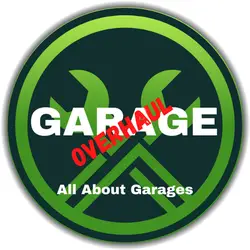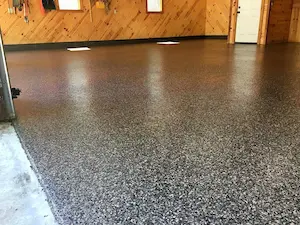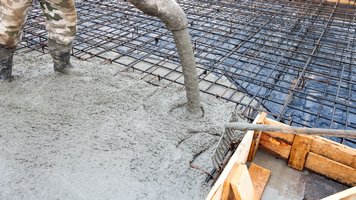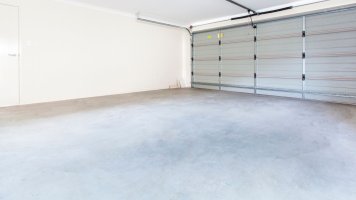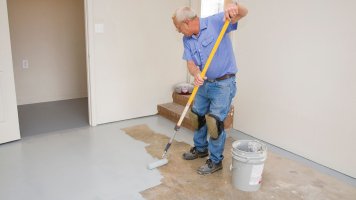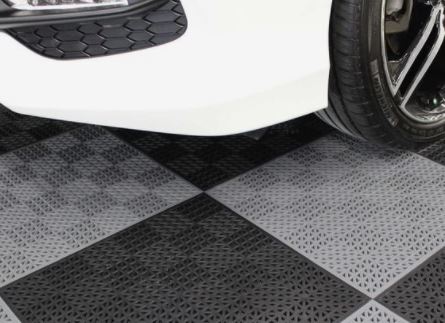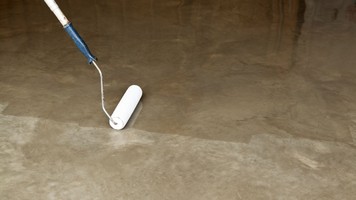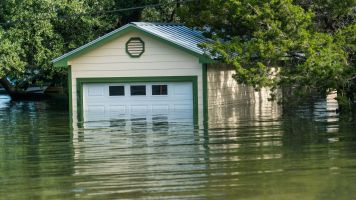Garage Flooring Guide: Paint (Info & Things You Should Know)
This post contains affiliate links.
Painting the garage floor is an easy and cheap way to improve and transform the whole look of the garage. Painting the floor is fast, and you only need to clean the floor properly beforehand.
Painting the garage floor prevents dust, protects the floor, and you have an easier time cleaning the whole garage. Adding paint also brings more light to the garage, and you’ll have a nicer-looking garage for a low price and fast application time for the whole project.
In this article, we look at different paints suitable for garage floors. Talk about possible downsides and how to paint the floor. We also take a look at epoxy paints.
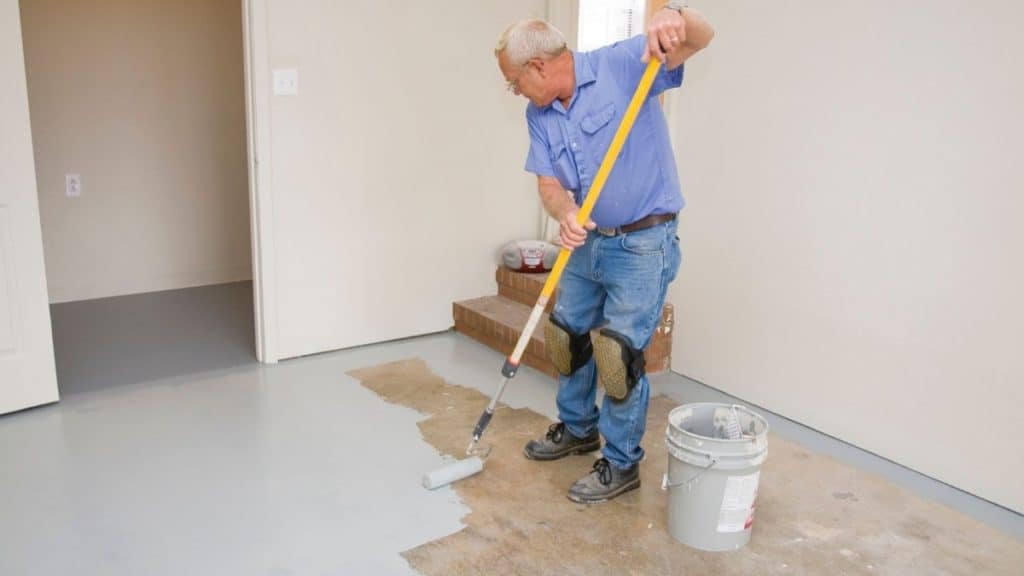
Should I Paint My Garage Floor?
Painting the garage floor is easy, cheap and it can completely transform the look and feel of the whole garage. All it takes is to clean the floor properly and know how to use a paint roller and brush. And you will get the job done.
Pros:
- Prevent Dust – Bare concrete floors make a lot of dust. The majority of the dust in the garage comes from the floor. The concrete surface slowly breaks into microscopic dust that becomes airborne every time you open the garage floor or pull the car out. The dust then settles on every surface in the garage. The only way to prevent concrete dust is to paint the floor or seal it with a concrete sealer.
- Easier Cleaning – When the concrete itself doesn’t shed dust, it is easier to keep the whole garage clean. You can just mop or vacuum the floor. Also, the concrete dust, dirt, and other stuff won’t get into the house in your or your kid’s shoes.
- Floor Protection – Quality paint adds moderate protection to the surface of the concrete. The floor will be more resistant to oil, water, mold, chemicals, and other stains. It’s also easier to clean the floor without fear of permanent stains.
- The Price – Painting the concrete is an inexpensive way to add color and protection to the floor. A gallon of latex acrylic paint is about $30-$40. Two gallons is enough for most 2 car garages.
- More Light – Painting the floor makes the garage brighter. Bare concrete absorbs light while paint reflects it.
- Better Looking Garage – The floor area has lots of square feet, and making that surface colorful will impact the whole look and feel of the garage in a big way.
Cons:
- Repainting – Most paints don’t last and need to be repainted every once in a while.
- Hot Tire Pickup – Some paints are susceptible to hot tire pickup. Leaving bald spots on the floor where the tires are.
- Chipping and Peeling – Cheap paints will chip and peel away over time.
Types of Garage Floor Paint
There are generally two types of garage floor paints to choose from that are widely available. Latex acrylic paint and 1-part epoxy paint.
There are latex acrylic paint, epoxy paint, polyurea paint, polyurethane paint, and polycuramine paints to choose between for garage concrete floors. Anti-slip flakes can be added to the paint for slip protection and color acrylic chips to enhance the colors.
With most paints, you can apply colored acrylic chips to enhance the look even more. If you live in a snowy or wet climate, then anti-slip flakes are recommended to be added to the paint to make the floor non-slippery.
Latex Acrylic Paint
Common and easy to apply and has a wide variety of colors. Resistant to water, mold, and mildew. Easy to clean. Moderately resistant to automobile fluids if cleaned quickly. Can stain from oil and antifreeze. Can peel off with gasoline or brake fluids. Will probably peel and chip over longer periods. Needs to be repainted more regularly than other types.
Epoxy Paint
Pre Mixed One Part Epoxy – Has added epoxy in the mix to improve the durability over standard paint. Easy to apply and has a wide variety of colors. Mold, mildew, water, and chemical resistance. Gasoline and brake fluids can make the paint peel off and should be cleaned off fast. But more durable than acrylic paint. Bonds better to the surface than latex acrylic. More resistant to chipping and peeling too.
Two-Part Epoxy Paint – Technically, not paint. Actually a 2 part epoxy product that is marketed as paint. Has a lower percentage of solids content by volume than real epoxy. These are easier to apply and provide a thin coat, the same as paint does. Most are sold as single coat kits with an option to add a second coat of clear epoxy to improve look and durability.
Two-Part Epoxy Floor Kits – Are not actually paint at all or painted to the floor. Read all about real epoxy floors in this article.
Polyurea Paint
Polyurea is a very fast-drying paint with some brands ranging from only 5 seconds to 5 minutes. It bonds well to the concrete but is not really resistant to automobile fluids or other chemicals. This type of paint is also not common and hard to find in any bix box home improvements stores or any major brands.
Polyurethane Paint
One of the most expensive options. But has good resistance to chemicals, heat, and humidity that affect the durability of regular paints. Needs proper surface preparations to bond correctly with the concrete.
Polycuramine Paint
It was developed by RockSolid Floors before Rust-Oleum bought the company. Polycuramine is a combination of epoxy, polyurea, and polyurethane and is a robust coating with quick dry times. It is very thick and can fill any small cracks or holes in the garage floor. It’s expensive, though.
What’s the Best Paint for Garage Floors?
1 Part epoxy paint is a better choice overall than basic latex acrylic paint. Epoxy resin is mixed with acrylic latex to make the paint more resistant to stains, oil, mold and mildew, gasoline, chemicals, and chipping or peeling. It also bonds better to the surface.
Acrylic paints will have a great color selection at a reasonable price. These sometimes need protective coating added on top of the paint. It should last 2-3 years.
Latex paint will give you a fresh look cheaply. But it usually needs to be repainted every year.
Garage Floor Paint Appearance
Most garage floor paints have a flat or satin finish. To get that glossy look, you need epoxy or polycuramine paint, and even only some of them can provide that. You could try some glossy coating/sealing that works with the paint. Suppose you are thinking about adding an additional epoxy/sealer layer. In that case, you might go with better and more expensive paint in the first place.
Most people paint the floor because it’s the cheapest garage flooring option. If you need a showroom finish, you need to consider spending more and go with real epoxy, or there is a variety of tiles to choose from. Even stains/dyes and sealers do a better job than paints.
Garage Floor Paint Maintenance
Like all flooring options for the garage, the paint needs to be maintained too with regular cleaning. You should wet mop and dust the floor regularly and perform a deep cleaning semi-annually.
A pressure washer is not recommended for cleaning painted areas. You can damage the paint easily.
Read all about cleaning the garage in this article.
Read about suitable paints for garage doors here.
Hot Tire Pickup in Garage Floor Paints
Most garage floor paints are prone to hot tire pickup at some point in their lifespan.
Hot tire pickup happens when a hot car tire sits on the paint and heats the paint’s bond with the concrete. The tire’s footprint shrinks when the tire cools, and it causes the paint to collect up with the tire. When you pack out of the garage, you end up with bare spots on the floor where the tires were.
This is common with low-quality floor paints and can be circumvented using mats or other types of coverage under the tires.
How to Paint Your Garage Floor
Old, oil-stained, cracked concrete is a tough candidate for any garage floor coating. Most coatings need to adhere correctly, and if the floor is in awful condition, some other flooring option like mats or plastic tiles is an easier choice.
But if the floor is in moderate condition, you can sweep, pressure wash, etch and patch the concrete for any coating over a weekend.
Make sure to pick the right time of the year when temperatures are between 50-90F or 10-32c. And the humidity is low.
Always make a moisture test to the concrete before starting any garage floor coating projects. If there is a lot of moisture coming through the slab, most of the floor coatings will fail over time. They will peel off and crack.
Moisture Test – Cut a piece of plastic and tape it with duct tape around the perimeter of the plastic piece and to the garage floor’s surface. Let it sit for 24 hours and peel it up. If there is water condensation underside the plastic or dark spot in the floor, you have moisture coming through the slab. You then can do a calcium chloride test to see how much moisture there is. If there is no moisture, you should be okay with any floor coating. Make the test in the wetter part of the year.
If there is a lot of moisture coming up. Then sealing the floor with a proper water barrier is a must before any coating. Or you can use plastic tiles that can breathe if you consider other flooring options.
Do I Need to Etch the Concrete Before Painting?
Water Drop Test – Apply a few drops of water to the surface. If the water gets absorbed into the surface, you can usually paint the floor with no problems. If the water beads at all, you need to etch the surface. The concrete may be sealed or have a slightly polished finish. Paint will not adhere to a non-porous surface.
Concrete is naturally very porous and quickly absorbs oil, dirt, and other contaminants that won’t allow the paint to bond with the surface properly. So just hosing out the garage with soap and water is not enough.
Etching the Concrete Surface Before Painting
- Sweep the surface carefully and wash the concrete with a degreaser.
- Before acid-washing the concrete, any previous sealer or paint should be removed with a surface grinder.
- Saturate the concrete thoroughly with a hose before acid washing. Acid should never be poured on dry surfaces. It’s meant to be mixed with water on the floor surface.
- Get a buddy to help you. Another person pours the acid solution from the watering can. The second person then brooms the surface in a circular motion to spread the acid solution. Bubbling and foaming are signs that the acid is reacting to the concrete.
- Make sure the reaction happens onto the entire surface of the floor. Avoid walking in the area that has been worked on already. Acid stops reacting to the surface after 30 seconds, so there is no need to scrub surfaces too long. Finally, flush the area carefully to remove all the neutralized acid from the surface. Let the surface dry thoroughly.
Cleaning the Concrete Floor Before Painting
First is best to remove all items from the garage. This is an excellent time to clean the whole garage or have a garage sale.
Rent a pressure or power washer or floor buffing machine. They are best for the job. Use a degreaser solution and wash the floor thoroughly. If you do not have access to any machinery, use a stiff-bristled scrubbing brush and a water hose with a high-pressure nozzle. Don’t let any cleaning solution dry to the surface.
Fill all the cracks and holes in the floor next. Get a concrete patch or repair compound. Wipe excess off with a wet rag or scraper to get a smooth surface. Let them dry enough between layers. Check the curing time before applying paint/primer.
Etch the surface if you need to.
Apply primer paint. This helps the actual paint to bond better. Let it dry before applying paint.
Apply the paint itself. Always check the manufacturer’s recommendations before starting the actual painting process.
How Long It Takes for Garage Floor Paint to Dry?
Application time is something to consider. Suppose you only have limited time for the garage to be out of commission. In that case, your options become limited, or you need to consider some other type of garage flooring option.
Application time for paints varies. Some can be dry touch in a couple of hours and can be driven on within 24 hours. Epoxy coatings can take days to cure. Curing refers to drying and hardening the coating before the floor is ready for use.
Paint Type – This plays a significant factor in the drying time. Oil-based paints like polyurethane will be touch dry in about 6-8 hours. However, it needs at least 16 hours to recoat or allow light traffic. Oil-based polyurethane dries fully in about a week. Epoxy paints have similar times.
Always check what the manufacturer recommends before walking on the surface or pulling the car in.
Drying times recommended by the manufacturer only apply if you take the right approach to the application itself. Thickly applied paints need more time to dry. If you recoat before the last layer is fully dry, the overall time may increase twofold.
Apply thin and even layers if you want the paint to dry faster. Or purchase paint specifically designed to dry fast.
Environment – Drying times depend heavily on temperature and humidity. If your region has humid air, the drying times become longer. The same is true for low temperatures. You may also have problems with paint adhesion to the concrete surface.
Make sure to pick the right time of the year when temperatures are between 50-90F or 10-32c, And the humidity should be between 40-70%.
Ventilation – If the air is stagnant, the drying time increases. The airflow should be sufficient in your garage. If you can’t open windows or doors, you can consider using fans to speed up the process. But fans have a downside. They can move dirt particles and ruin your new floor coating fast.
How to Paint Already Painted Concrete Floor
Existing paint needs to be sanded before applying a new coat. This is easiest with orbital floor sander, pole sander, or similar machinery designed to sand large surfaces. The machines can be rented. After sanding, vacuum the surface and wash it with a pressure washer or hose. Allow the floor to dry before applying a new coat of paint.
Very old paint can have lead in it. Lead dust is toxic, and removing the paint is best to leave to the professionals. If you suspect there is lead in the paint. Scrape off a tiny bit and have it checked out. More info in the government website Lead | US EPA
Garage Floor Paint Cost
- Latex Acrylic Paint – starts at $20 per gallon.
- 1 Part Epoxy Paint: Start at $30 per gallon.
- Polycuramine kit for 2 car garage start about $200
Check how much the manufacturer says one-gallon covers. Also, keep in mind that you might need two or three layers. So check how many layers are recommended.
One gallon can cover about 170-500 sq. ft, so this ranges wildly depending on the type of paint.
Read here how to calculate your garage floor square footage.
The national average materials cost to paint a garage floor is $0.78 per square foot, ranging between $0.57 to $0.99. The total price for labor and materials per square foot is $2.65, coming in between $1.79 to $3.51. A typical 300 square foot project costs $794.53, ranging from $535.69 to $1,053.38. Your actual price will depend on your location, job size, conditions, and finish options you choose. (source porch.com)
Helpful Links
How Much Does It Cost To Paint A Garage Floor? (porch.com)
How Much Does It Cost To Paint A Garage Floor? (2021 Estimates) – Pro Paint
How Much Does It Cost To Paint A Garage Floor? (2021 Updated Guide) (thatpainter.com)
Cost to Paint Garage Floor – 2022 Cost Calculator (Customizable) (homewyse.com)Corner
Can You Paint Over the Garage Epoxy Floor?
Real epoxy floors are not painted. But if the floor is previously painted with epoxy paint, you can repaint over it.
Read all about real epoxy floors here.
Epoxy paint is durable and scratch-resistant but doesn’t last forever. You have to ensure that the new coat is compatible with the old one. Get info from the manufacturer first. The rule of thumb is if the existing floor contains resins like polyurethane, polyurea, or polyaspartic, you should be able to paint over it.
Check the condition of the existing floor. If there are signs of delamination or peeling, repaint should be avoided.
Delamination is when the painted surface starts to crack into specific layers. If you can pull flakes off and see different layers underneath, then that’s delamination at work. Usually, you have to grind the whole surface to remove all layers of paint or other floor coatings.
How to Paint Over Garage Epoxy Floor
Repair all the holes, cracks, and chips on the surface. Use epoxy patching compounds or patching mortar. Let them dry recommended time by the manufacturer. Patching mortars can take up to two months to dry.
The floor needs to be coarse enough for the new paint to stick.
Sand the floor with an orbital sander or pole sander with 120-grit sandpaper. Another option is to use a floor buffer with a 100-grit sanding screen. You can rent the machines.
End of the sanding process, the floor should have fine scratch marks. Sweep up the residue and vacuum the floor using a shop vac.
Clean the floor with a degreaser and a pressure washer or scrub brush. Get all the stains and dirt out. If any is left over after the sanding process. Let the surface dry. You can also use denatured alcohol. It evaporates quickly, so you don’t have to wait for the surface to dry.
Measure your garage square footage to get the right amount of paint. You don’t want too much or too little paint when starting the project.
Then it’s time to paint a new coat. Follow the manufacturer’s instructions on how to apply the paint. Most garage floor epoxy paints have special instructions.
Start from the edges with a paintbrush and then use a paint roller coming towards the garage door. Depending on the manufacturer, you may need a second or even third layer.
Let the surface dry the recommended time before walking on it or parking your car.
How Long Does Garage Floor Paint Last?
There are many flooring options for the garage floors to choose from, and paint is the cheapest and least durable.
If appropriately applied, most garage floor paints last about 2-5 years, depending on the usage of the garage. Garage floor paints are not the most durable option for your garage floors. However, repainting the floor is fast and easy.
The garage floor has to take a lot of beating. Chemical spills, abrasion, heat, cold, ice, snow, road salt, dirt, and everything you or mother nature throw at it and frequency of usage of the floor all wear and tear the surface.
Check also other articles in the floor coating series.
